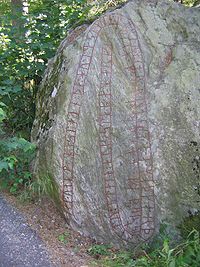
Fyrby Runestone
Encyclopedia

Rundata
The Scandinavian Runic-text Data Base is a project involving the creation and maintenance of a database of runic inscriptions. The project's goal is to comprehensively catalog runestones in a machine-readable way for future research...
catalog, is a Viking Age
Viking Age
Viking Age is the term for the period in European history, especially Northern European and Scandinavian history, spanning the late 8th to 11th centuries. Scandinavian Vikings explored Europe by its oceans and rivers through trade and warfare. The Vikings also reached Iceland, Greenland,...
memorial runestone located in Fyrby, which is about 15 kilometers south of Flen
Flen
Flen is a locality and the seat of Flen Municipality, Södermanland County, Sweden with 6,114 inhabitants in 2005.Flen is most known for being the one place on earth where hot dogs are free....
, Södermanland
Södermanland
', sometimes referred to under its Latin form Sudermannia or Sudermania, is a historical province or landskap on the south eastern coast of Sweden. It borders Östergötland, Närke, Västmanland and Uppland. It is also bounded by lake Mälaren and the Baltic sea.In Swedish, the province name is...
, Sweden
Sweden
Sweden , officially the Kingdom of Sweden , is a Nordic country on the Scandinavian Peninsula in Northern Europe. Sweden borders with Norway and Finland and is connected to Denmark by a bridge-tunnel across the Öresund....
.
Description
The runic inscription on the Fyrby Runestone consists of runic text within a band that curves along the face of the north side of a granite boulder that is two meters in height. The runic inscription is classified as being carved in runestone style RAK. RAK is the classification for the oldest style where the ends of the runic bands are straight and there are no animal designs. The inscription is considered somewhat enigmatic due to its use of the pronoun "I" at the beginning of the runic text, which might even refer to the stone itself speaking. This runestone is notable for its reference to MidgardMidgard
Midgard is one of the Nine Worlds and is an old Germanic name for our world and is the home of Humans, with the literal meaning "middle enclosure".-Etymology:...
("Middle Earth"), which was one of the nine worlds of Norse cosmology
Norse cosmology
The cosmology of Norse mythology has 'nine homeworlds', unified by the world tree Yggdrasill. Mapping the nine worlds escapes precision because the Poetic Edda often alludes vaguely, and the Prose Edda may be influenced by medieval Christian cosmology...
and the home of humans.
The runic inscription contains a memorial to a father from his two sons which also boasts of the skills of the sons in rune-making, claiming that the brothers were the most skilled in runes in Miðgarði or "Middle Earth." One personal name in the inscription contains the name of the Norse pagan
Norse paganism
Norse paganism is the religious traditions of the Norsemen, a Germanic people living in the Nordic countries. Norse paganism is therefore a subset of Germanic paganism, which was practiced in the lands inhabited by the Germanic tribes across most of Northern and Central Europe in the Viking Age...
god Freyr
Freyr
Freyr is one of the most important gods of Norse paganism. Freyr was highly associated with farming, weather and, as a phallic fertility god, Freyr "bestows peace and pleasure on mortals"...
as a theophoric name element. The father's name, Freysteinn, means "Freyr's Stone." In addition, the Hár or "High" in the name Hásteinn, which means "High Stone," may refer to a byname of the god Odin
Odin
Odin is a major god in Norse mythology and the ruler of Asgard. Homologous with the Anglo-Saxon "Wōden" and the Old High German "Wotan", the name is descended from Proto-Germanic "*Wodanaz" or "*Wōđanaz"....
. The names in the Fyrby Runestone inscription also reflect a common practice of that time in Scandinavia of repeating an element in a parent's name in the names of the children. Here the steinn from the father's name, Freystein, is repeated in the names of the two sons, Hásteinn and Holmsteinn, to show the family relationship.
Inscription
.jpg)
In Unicode
- ᛁᛅᚴ᛫ᚢᛅᛁᛏ᛬ᚼᛅᛋᛏᛅᛁᚾ᛬ᚦᛅ᛬ᚼᚢᛚᛘᛋᛏᛅᛁᚾ᛬ᛒᚱᚢᚦᚱ᛫ᛘᛂᚾᚱ᛬ᚱᚢᚾᛅᛋᛏᛅ᛬ᛅ᛬ᛘᛁᚦᚴᛅᚱᚦᛁ᛬ᛋᛂᛏᚢ᛬ᛋᛏᛅᛁᚾ᛬ᛅᚢᚴ᛬ᛋᛏᛅᚠᛅ᛬ᛘᛅᚱᚵᛅ
- ᛂᚠᛐᛁᛦ᛫ᚠᚱᛅᚤᛋᛏᛅᛁᚾ᛬ᚠᛅᚦᚢᚱ᛫ᛋᛁᚾ
Transliteration of the runes into Latin characters
- iak * uait : hastain : þa : hulmstain : bryþr * menr : rynasta : a : miþkarþi : setu : stain : auk : stafa : marga eftiR * fraystain * faþur * sin *
Transcription into Old Norse
- Ek veit Hástein þá Holmstein brœðr menn rýnasta á Miðgarði, settu stein ok stafa marga eptir Freystein, fôður sinn.
Translation in English
- I know Hásteinn and Holmsteinn, the most rune-skilled brothers in Middle Earth, placed many a stone and staff in memory of Freysteinn, their father.
Alliterative verse
It has been noted that the inscription on the Fyrby Runestone can be read in the form of alliterative verseAlliterative verse
In prosody, alliterative verse is a form of verse that uses alliteration as the principal structuring device to unify lines of poetry, as opposed to other devices such as rhyme. The most commonly studied traditions of alliterative verse are those found in the oldest literature of many Germanic...
known as Fornyrðislag:
| style="padding: 1pt 10pt;" |
Ek veit Hastein
þa Homstein brœðr
mennr rynasta
á Migarði
settu stein
ok stafa marga
eftir Frøsten
faður sin
| style="padding: 1pt 10pt;" |
I know Hásteinn
and Holmsteinn
the most rune-skilled brothers
in Middle Earth
placed many a stone
and staff in memory
of Freysteinn
their father
|
|}

